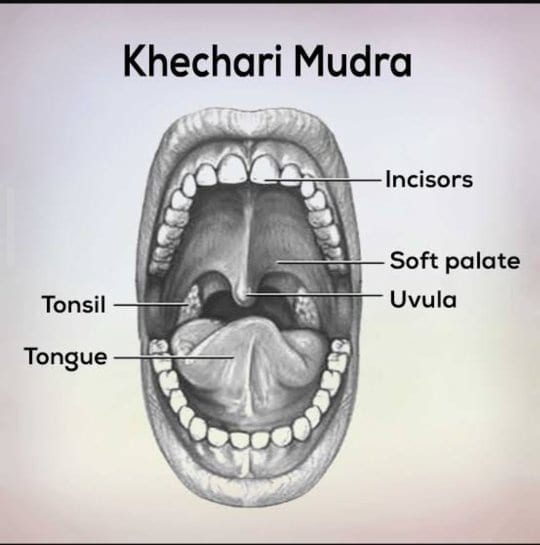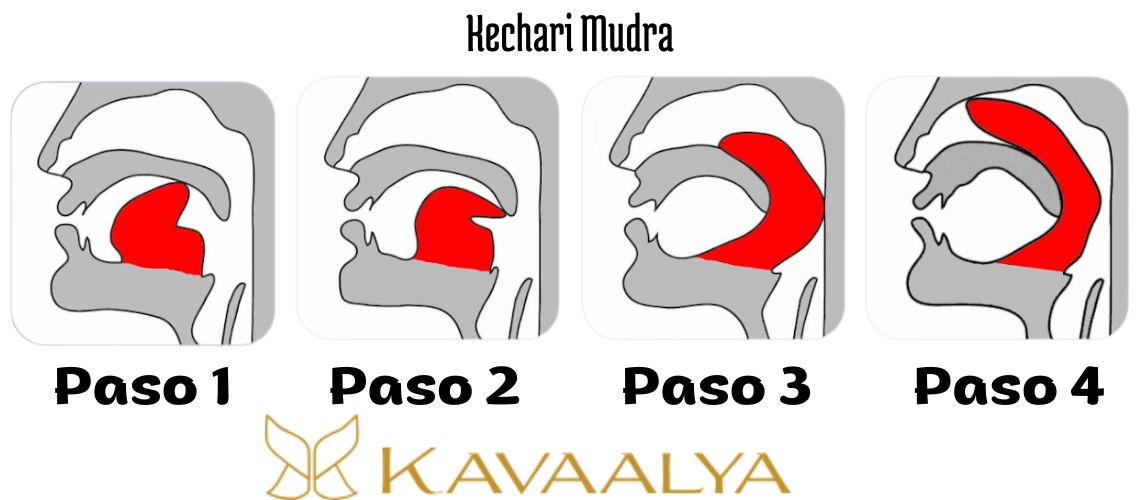What is Kechari Mudra and why is it so powerful?
The Kechari Mudra is an advanced technique of hatha yoga and tantric yoga. It consists of bringing the tongue to the back of the palate, trying to reach the nasal cavity. It is considered a powerful mudra because it unlocks the flow of internal energy.
This practice is believed to activate the pineal gland, promoting the expansion of consciousness and facilitating deep states of meditation. Many yogis claim that Kechari Mudra helps to connect with subtle planes and experience greater control over the mind and emotions.
Unlike other mudras, which are performed with the hands, Kechari Mudra works directly with the nervous system and the prana. Its name in Sanskrit means “the mudra that moves through the ether”, as it is said to allow transcending the physical plane.
Ancient texts like the Hatha Yoga Pradipika describe it as a practice capable of granting control over the senses. Additionally, it is associated with the ability to attain samadhi, a state of deep calm and enlightenment.
Beyond the spiritual, this mudra has a physiological basis. Stimulating the upper part of the palate activates a neurological response that induces deep relaxation. It can also help reduce stress and promote the production of melatonin, improving sleep.
Achieving full practice requires patience and training, as the tongue must become more flexible over time. However, those who persevere assure that their physical and mental benefits make the effort worthwhile.
What is the Talu Chakra and what is its relation to Kechari Mudra?
The Talu Chakra is a little-known energy center in the traditions of tantric yoga and kundalini yoga. It is located in the soft palate, right where the tongue makes contact in the practice of Kechari Mudra.
This chakra is not often mentioned in classical seven chakra systems, but some traditions consider it a key point in the activation of spiritual energy. It is said to be a bridge between the pineal gland and the throat, facilitating the connection with higher planes of consciousness.

Talu Chakra and its connection with Kechari Mudra
When practicing Kechari Mudra, the tongue stimulates the Talu Chakra, awakening its energy. This favors the secretion of that, according to some texts, nourish the brain and activate the pineal gland, assisting in the expansion of consciousness.
It is believed that this activation allows for easier access to deep states of meditation and experiences of samadhi. Additionally, by connecting with the energetic flow of the spine, it helps to direct the prana towards the brain, enhancing the practice of Kriya Yoga.
Benefits of Talu Chakra Stimulation
When working in this area, some practitioners experience a feeling of coolness in the head, greater mental clarity, and an increase in introspection. It is also associated with the ability to reduce hunger, improve sleep, and enhance spiritual vitality.
Kechari Mudra is not only an advanced yoga technique but also a tool to access this hidden energy center. Its constant practice can lead to a profound transformation in perception and in inner awakening.
How to practice Kechari Mudra safely?
The Kechari Mudra is an advanced practice that requires patience and discipline. It is not just about moving the tongue, but training it to achieve a flexibility and strength that allows for the execution of the mudra without discomfort or risks.
Step 1: Prepare the tongue
Before attempting Kechari Mudra, it is important to strengthen and flexibilize the tongue. A useful exercise is to press it against the palate and gradually stretch it back. It is also recommended to massage the frenulum with your fingers to increase its elasticity.
Some traditions suggest gradually cutting the lingual frenulum to allow for greater mobility. However, this is not necessary and can be risky. Constant practice and patience can achieve the same effect without resorting to invasive methods.
Step 2: Position the tongue correctly
The first goal is to take the tongue to the deepest part of the soft palate. This is achieved by pressing it against the roof of the mouth and sliding it backward. At first, it may feel uncomfortable, but over time it becomes easier.
Once the tongue gets used to this position, the next step is to try to introduce it into the nasopharynx, the area that connects the nose to the throat. This is the most advanced stage and can only be achieved with constant practice.
Step 3: Synchronize with breathing and meditation
While practicing Kechari Mudra, it is key to combine it with a deep and conscious breathing. Inhaling and exhaling in a controlled manner helps to relax the body and enhance concentration, facilitating a deeper experience in meditation.
Over time, this mudra can be integrated into practices such as Kriya Yoga, enhancing internal energy and facilitating the connection with elevated states of consciousness. The more fluid the practice, the more benefits can be experienced.

Final tips for safe practice
The progress must be gradual. Forcing the tongue beyond its capacity can cause discomfort or even injury. It is advisable to practice daily, but without rushing. Consistency is key to achieving the benefits of this powerful mudra.
Benefits of Kechari Mudra for the body and mind
The Kechari Mudra is not only an advanced technique of hatha yoga, but also a powerful tool for transforming internal energy. Its constant practice can bring about profound changes in the body, mind, and state of consciousness.
- Activate the pineal gland and increase mental clarity: One of the most fascinating benefits of Kechari Mudra is its effect on the pineal gland. It is believed that the stimulation of the Talu Chakra promotes the production of melatonin, the hormone that regulates sleep and the perception of time. Additionally, some yogis claim that this activation awakens intuition and facilitates access to states of expanded consciousness. Regular practice can improve concentration and reduce “mental noise”.
- Promotes deep states of meditation: Kechari Mudra acts as a shortcut to elevated states of meditation. By directing the tongue towards the nasal cavity, a sensation of dissociation from the senses occurs, facilitating inner focus and access to samadhi (state of enlightenment). Many practitioners feel an increased ability to enter into mental silence and experience profound peace. For this reason, it is considered an essential mudra in Kriya Yoga and other advanced meditation traditions.
- Control hunger and improve longevity: In ancient texts like the Hatha Yoga Pradipika, it is mentioned that Kechari Mudra helps to reduce the sensation of hunger and thirst. Some yogis claim that this practice stimulates the production of an inner nectar known as “amrita”, which nourishes the body and prolongs life. While there is no clear scientific evidence about this nectar, many practitioners have reported a decreased need for food and an increased sense of vitality after months of consistent practice.
- Balances the nervous system and reduces stress: Kechari Mudra has a direct effect on the parasympathetic nervous system, which regulates relaxation and the body’s equilibrium. By practicing it, a deep sense of calm is activated, reducing levels of stress and anxiety. Additionally, it helps to control blood pressure, improve sleep quality, and reduce symptoms related to chronic stress. It is a powerful tool for those seeking greater emotional stability.
- Enhances energy and the flow of prana: This mudra not only affects the mind but also the energy flow of the body. It is said that by unlocking the Talu Chakra, it allows energy to rise along the spine and activate the higher centers of consciousness. In the practice of kundalini yoga, it is considered a booster for the awakening of kundalini energy, facilitating deep spiritual experiences. It is an essential practice for those seeking to expand their connection with internal energy.







